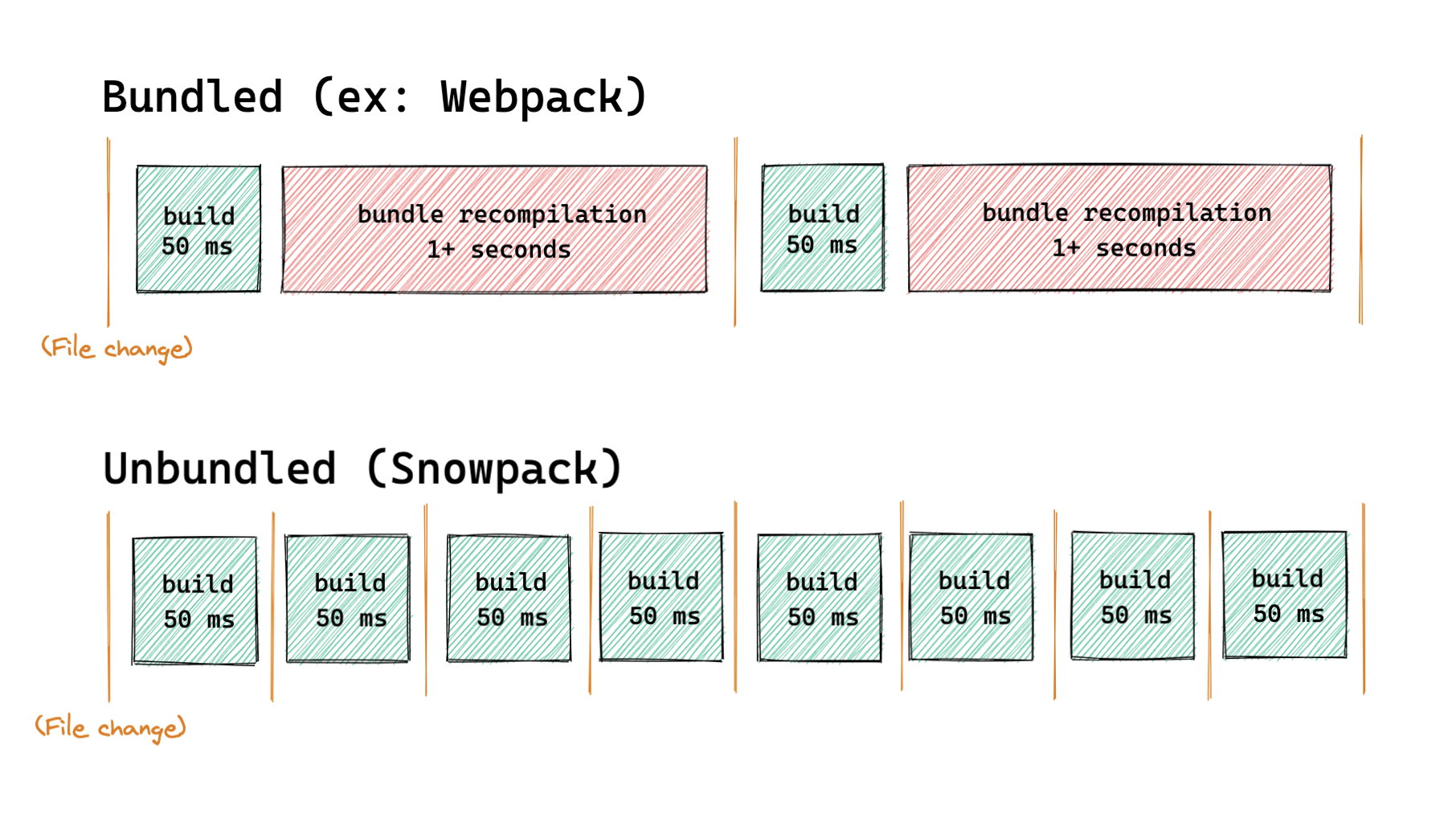Snowpack
Main Concepts
Unbundled Development

Unbundled development is the idea of shipping individual files to the browser during development. Files can still be built with your favorite tools (like Babel, TypeScript, Sass) and then loaded individually in the browser with dependencies thanks to ESM import and export syntax. Any time you change a file, Snowpack only ever needs to rebuild that single file.
The alternative is bundled development. Almost every popular JavaScript build tool today focuses on bundled development. Running your entire application through a bundler introduces additional work and complexity to your dev workflow that is unnecessary now that ESM is widely supported. Every change – on every save – must be rebundled with the rest of your application before your changes can be reflected in your browser.
Unbundled development has several advantages over the traditional bundled development approach:
- Single-file builds are fast.
- Single-file builds are deterministic.
- Single-file builds are easier to debug.
- Project size doesn’t affect dev speed.
- Individual files cache better.
That last point is key: Every file is built individually and cached indefinitely. Your dev environment will never build a file more than once and your browser will never download a file twice (until it changes). This is the real power of unbundled development.
Using NPM Dependencies
NPM packages are mainly published using a module syntax (Common.js, or CJS) that can’t run on the web without some build processing. Even if you write your application using browser-native ESM import and export statements that would all run directly in the browser, trying to import any one npm package will force you back into bundled development.
Snowpack takes a different approach: Instead of bundling your entire application for this one requirement, Snowpack processes your dependencies separately. Here’s how it works:
node_modules/react/**/* -> http://localhost:3000/web_modules/react.js
node_modules/react-dom/**/* -> http://localhost:3000/web_modules/react-dom.js
- Snowpack scans your website/application for all used npm packages.
- Snowpack reads these installed dependencies from your
node_modulesdirectory. - Snowpack bundles all of your dependencies separately into single JavaScript files. For example:
reactandreact-domare converted toreact.jsandreact-dom.js, respectively. - Each resulting file can be run directly in the browser, and imported via ESM
importstatements. - Because your dependencies rarely change, Snowpack rarely needs to rebuild them.
After Snowpack builds your dependencies, any package can be imported and run directly in the browser with zero additional bundling or tooling required. This ability to import npm packages natively in the browser (without a bundler) is the foundation that all unbundled development and the rest of Snowpack is built on top of.
<!-- This runs directly in the browser with `snowpack dev` -->
<body>
<script type="module">
import React from 'react';
console.log(React);
</script>
</body>Snowpack’s Dev Server

snowpack dev - Snowpack’s dev server is an instant dev environment for unbundled development. The dev server will only build a file when it’s requested by the browser. That means that Snowpack can start up instantly (usually in <50ms) and scale to infinitely large projects without slowing down. In contrast, it’s common to see 30+ second dev startup times when building large apps with a traditional bundler.
Snowpack supports JSX & TypeScript source code by default. You can extend your build even further with custom plugins that connect Snowpack with your favorite build tools: TypeScript, Babel, Vue, Svelte, PostCSS, Sass… go wild!
Snowpack’s Build Pipeline

snowpack build - When you’re ready to deploy your application, run the build command to generate a static production build of your site. Building is tightly integrated with your dev setup so that you are guaranteed to get a near-exact copy of the same code that you saw during development.
Bundle for Production
You should be able to use a bundler because you want to, and not because you need to. That was the original concept that Snowpack was designed to address. Snowpack treats bundling as an optional production optimization, which means you’re free to skip over the extra complexity of bundling until you need it.
By default, snowpack build will build your site using the same unbundled approach as the dev command. This is fine for most projects, but you also may still want to bundle for production. Legacy browser support, code minification, code-splitting, tree-shaking, dead code elimination, and other performance optimizations can all be handled in Snowpack via bundling.
Bundlers normally require dozens or even hundreds of lines of configuration, but with Snowpack it’s just a one-line plugin with no config required. This is possible because Snowpack builds your application before sending it to the bundler, so the bundler never sees your custom source code (JSX, TS, Svelte, Vue, etc.) and instead only needs to worry about building common HTML, CSS, and JS.
// Bundlers plugins are pre-configured to work with Snowpack apps.
// No config required!
{
"plugins": [["@snowpack/plugin-webpack"]]
}See “Optimized Builds” for more information about connecting bundled (or unbundled) optimization plugins for your production builds.